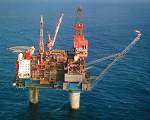Oil Exploration from the Sky: Fast and Wide
 As time goes by, better and better methods for finding mineral wealth, including oil, will be developed. This TechReview article reports on a new method of aerial search for oil reserves:
As time goes by, better and better methods for finding mineral wealth, including oil, will be developed. This TechReview article reports on a new method of aerial search for oil reserves:A new airborne technology for mapping oil fields could locate new oil reserves by drastically cutting survey costs, and help companies identify untapped oil within new reserves.Source.
Las Vegas, NV-based startup eField Exploration recently completed a survey of existing oil fields in Texas in which it revealed extensions of these fields into areas that traditional methods did not spot, according to company president Ed Johnson. Drilling to confirm the findings will likely begin soon, he says.
The new method uses existing electromagnetic imaging technologies in a novel airborne system that can quickly cover large areas, thus reducing costs. It also potentially reduces the environmental impact of exploration by eliminating the need to bulldoze wide roads for the heavy equipment used in seismic surveys.
According to Dan Burns, a research scientist in MIT's earth resources laboratory, while seismic surveys are currently by far the most common method of imaging oil fields, electromagnetic (EM) imaging is gaining in popularity because it is more reliable. Electromagnetic imaging is a more direct way to detect oil than seismic surveys, since it can measure differences between oil and water, something seismic methods can't do. "There's clearly a move more and more toward electromagnetics," Burns says. "In general, seismic techniques are responding to differences in the rocks themselves, as opposed to fluids, whereas EM methods are much more sensitive to fluids."
.....Because their method reduces costs, eField is also exploring another potential benefit: rapidly scouting for potential oil deposits in new areas or in areas that have already been mapped but with inadequate methods due to high costs. By quickly covering large areas (the Texas survey took in 3,100 miles) and generating maps in weeks instead of months, the new airborne technology can cut costs per "line mile" for large areas to about $100, Johnson says, rather than the hundreds of thousands of dollars per mile he says seismic surveys cost.
A person almost needs to be totally oblivious to the real world, to believe that most of the world's oil reserves have already been located, much less extracted. Fixation on earth-changing catastrophes is a natural stage in human development, but persons who get stuck in that fixation can easily lose touch with reality. This is true for religious apocalyptics as well as ideological apocalyptics.
There is plenty of room in the real world for those who want to solve problems.
Labels: oil exploration, oil production, peak energy, peak oil

0 Comments:
Post a Comment
Subscribe to Post Comments [Atom]
<< Home